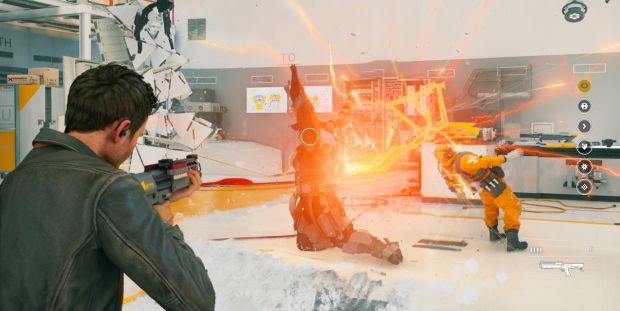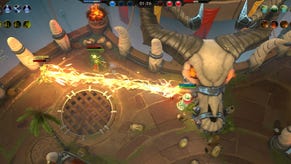Wot I Think: Quantum Break
Time To Think
Quantum Break [official site] has finally received a proper PC release via Steam (although sadly only Steam so far), rather than the ridiculous Windows Store. (A store that hides where it installs games on your PC, which isn't something you'll want with a 70GB game!) I've played it through for the very first time this week, and can tell you wot I think of this time travelling multimedia caper.
You may well already be completely aufait with Quantum Break, what with its having originally come out in April on the Xone Box, and even on something called the “Windows Store” whatever that might be. It completely passed me by at the time, so I started the game entirely blind when it appeared on Steam for the first time this week. I genuinely didn’t know what to expect, including that it contains four twenty minute TV episodes between its chapters. It is, undeniably, an epic, extraordinary creation, pushing at the edges of gaming storytelling and use of real-world actors, with a wibbly-wobbly timey-wimey plot to keep you unpicking it for weeks to come. It is also, oddly, a really average third-person shooter jam-packed with dumb ideas and lazy exposition.
They of Max Payne fame, Remedy, had enormously huge ambitions and presumably an enormous Microsoft cheque to create Quantum Break. This tale of time travel, evil corporations, and men who shoot other men in the head makes the bold and - in delivery - superb idea of casting proper real-life Hollywood actors in the game, creating their likeness in gobsmackingly stunning graphics, such that when it switches to the real actors on film it’s not nearly so jarring as you’d expect. X-Men’s Shawn Ashmore is the lead, and main player character Jack Joyce, an old school friend of pioneer and potential tech guru Paul Serene, played by Game Of Thrones’ Aidan Gillen. The two, at 4.15am one October morning, switch on a time machine, and in doing so rupture the fabric of time itself. Time gets broken, Paul gets flung into the future, and Jack finds himself in a position to survive attacks by elite armed guards what with his new-found time-based superpowers.
Jack’s brother (Lord Of The Rings’ Dominic Monaghan) was the scientist behind the time travel technology, and he’s quickly embroiled in the action, and then come a whole raft of other core characters from Lance Reddick’s moustache-twirling Martin Hatch and Courtney Hope’s intrepid, plucky Beth Wilder. Time starts collapsing all around the city, stutters freezing time in bubbles, with Jack able to move within them. And a corporation called Monarch is heavily involved in it all, seemingly desperate to stop Jack Joyce and bring about the End of Time.
The game portion of it all is delivered in an alternating sequence of trudging about and chatting, and third-person cover-based shooting. Combat is frenetic, loose, and designed to be thwarted with a combination of aiming guns at heads, and using your time powers such as trapping enemies in bubbles, speed running, and slo-mo shooting (it is Remedy, after all). And is, without doubt, wholly unoriginal in every possible way. It’s not bad, but it’s completely unremarkable, especially since time-controlling powers in combat are nothing new, with (mediocre) games like Raven’s Singularity (2010) and Sabre’s TimeShift (2007) having done it all before.
In all instances you run to cover (automatically snapped into, but not particularly well), slow down whatever you can slow down, and pop a few headshots. Move on. There are a couple of sequences with tougher baddies you have to, well, run behind, and that’s it. Failure did not come often. Until the final battle, of course, where it naturally had to become stupid and starting killing me with one-hit kills from five different directions at once, but hey, video games.
This isn’t unpleasant, and there are occasions where manipulating the battlefield with your powers offers some fun, but it’s mostly mercenary work. When you’re not fighting, you’re most likely chatting to other characters, and this is all completely splendidly delivered, but for one rather key issue.
The game is such an inexplicable mix of the best and worst of game storytelling. This incredible beauty, uncanny-valley-nudging human faces, superb voice acting, an intriguing plot about the breaking of time, is all delivered wonderfully. But to actually know what they’re talking about most of the time, you have to run around incongruously to the nature of a scene, pressing E on highlighted objects. “Follow me,” a character will say. “Sorry, just a minute,” you’re required to think in reply, “I’ve got to run down all these dead ends in case a pinboard tells me what it is you’re about to allude to.” “Quickly, they’re coming! We have to escape!” “Okay, sure, no problem, but I’m just going to read a couple of emails over there so I know why.” It’s crazy. They hired fantastic actors, got splendid performances out of them, and then tell the core of the story in scattered-about diary entries.
In the first half, if you want to know who people even are, you’re going to have to seek out these collectibles. There are attempts to incentivise this, with promises of extras and changes to the filmed sequences depending upon what you find, as well as unlocking audio diaries that themselves contain really quite vital information. But the reality of the game is, from start to finish of this enormous story (I think the game took me around 12-14 hours, which is an awfully long time for something so plot heavy), you’re engaged in this farcical act of stopping to read people’s emails while the characters around you are shouting for you to hurry because the world’s about to end. Even in the final chapter, to know who the bloody hell Dr Kim is, to keep up with the alternating allegiances of another key character, to really have a grip on an increasingly unraveling storyline, you need to read emails that are thousands of words long.
It’s so silly! You’re literally racing the end of time, and you’re stopping to stare at a tablet for however long it takes you to read a couple of two thousand word emails, and the game’s really encouraging you to do this! The other characters aren’t, but the game itself pushes the idea that you should. All these poor brilliant actors hired to fill in between the main plot that was accidentally delivered on paper.
The structure is very peculiar, but delightfully experimental. In between the five acts are these four filmed “episodes”, the same cast by now their actual human forms, providing a perspective of the story from the side of the employees of Monarch. (I am having to be very careful about what I say as mentioning names really does spoil early surprises.) They’re less special effects intensive than the game’s own cutscenes, presumably to save some costs, but look splendid, and appear in the game in crisp HD.
Aidan Gillen, it turns out, can act when he’s not trying to do his inexplicable wormy-squirmy Game Of Thrones accent! He’s putting on a fine American lilt here, and it’s like a whole different Littlefinger, you’ll be relieved to learn. He’s no longer like listening to a sentient sigh. There’s really not a duffer in the cast, and these sections make for a nice break from the action, let you sit back in your chair, and soak in a bit more story from another perspective.
But why they’re there? Why it was imperative that this be the game to intermix action video game and live action film? I can’t think of a single reason. I love that they did it, I love that there was a desire to meddle with formats and be original, but I wish they’d also come up with a good reason for doing so.
While playing, goodness me, Remedy’s new Northlight engine is something damned special. Representing the breakdown of time is not an easy ask, but this delivers such spectacle, such enormous set pieces with incredible scale of action, and yet does this not in cutscenes but all around you as you play. There’s a sequence in which you’re crossing an enormous road bridge, which is midway through being ripped apart by an enormous ship crashing into it. The moment this is happening is caught in a stutter, juddering backward and forward, vast towers of metal collapsing and restructuring, cars falling up and down, jittering between, while you attempt to run and jump through it all. It’s epic.
And then in the tiniest details it’s wonderfully realised too. Time, you’ll be interested to learn, is made of triangles. And these rip and tear and float and flitter, objects fracturing and reconstructing, people’s faces breaking down into polygons, the world tearing itself apart and putting itself back together. It all looks just so incredible, so unceasingly complicated and gorgeous. (The stills cannot do it justice - it's so much about the flow of the animation.) While I’ve far preferred the aesthetic choices of other games, I can’t think of one that has used top-notch graphics so powerfully.
And then I get killed during a cutscene. It really is the most polar of games, these wonderfully huge ideas, these overwhelmingly ambitious graphics and massive-scale set pieces, and then terribly checkpointed repetitive shoot-outs and this daft, mundane trudging about (it just cannot get enough of robbing you of your time powers to make sure you’re concentrating) and reading wall charts and email accounts. It writes this elaborate and increasingly convoluted story (it's not exactly Primer) of twisting time loops, and then mangles it between three different deliveries. And of course its ending trousers cannot match its build-up mouth, with so many threads left completely forgotten or muddled, and an anti-climax so egregious I found it weirdly dishonest.
I love that they reached so high, but I really wish they’d thought harder about what it was they were trying to balance on as they did. Ambition wasn’t thwarted by technology, but just a lack of common sense. I find myself still wanting to recommend you play it, not least because the action is mostly fine, if very repetitive, and therefore there’s nothing that’s actively unpleasant about playing it - you can experience the wonders it has to offer, just for the price of grinding through the okay-ness of it all. That’s not a hearty recommendation, of course, but it remains one of the most fascinating AAA games I’ve ever played, even if it can’t realise a lot of what it set out to do.
Quantum Break is out now on Steam for £30/€37/$40.


















